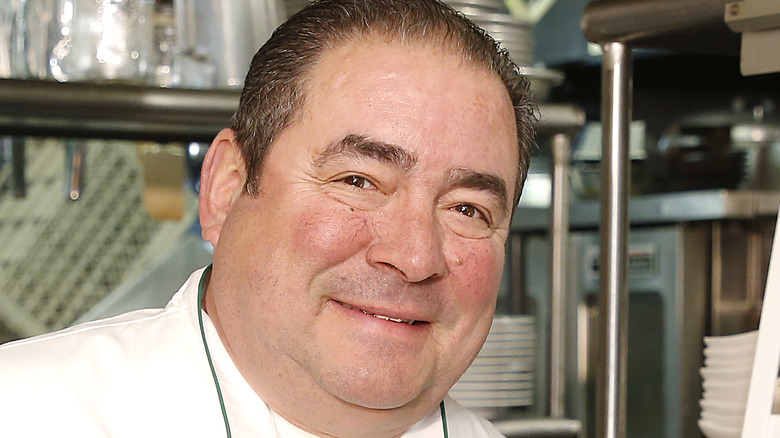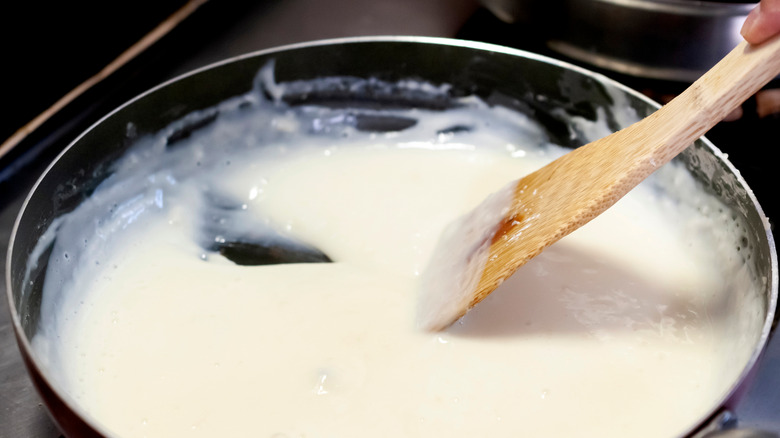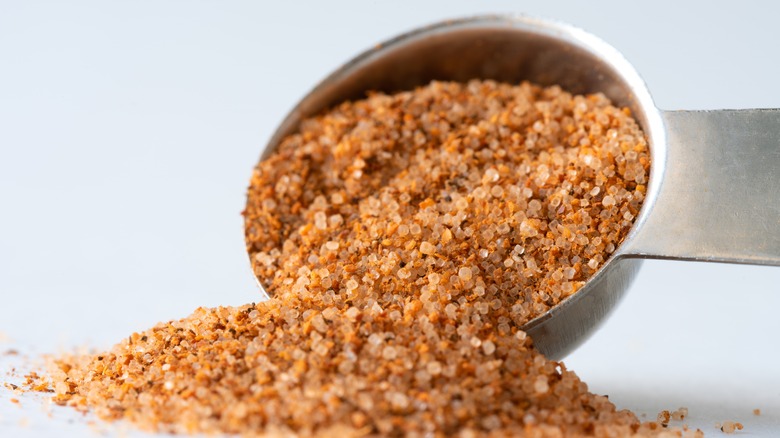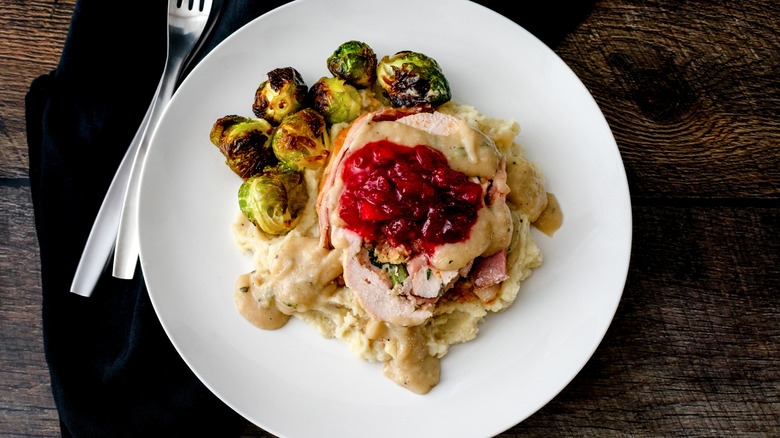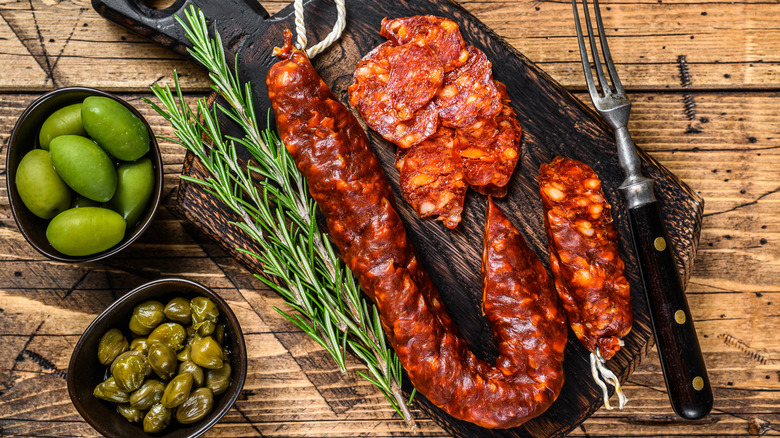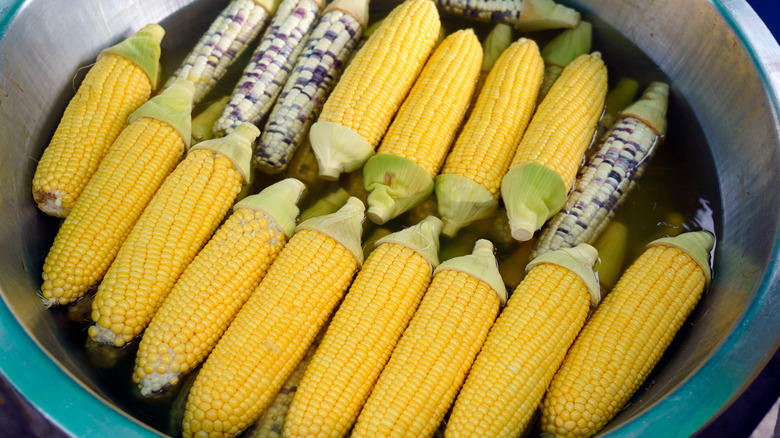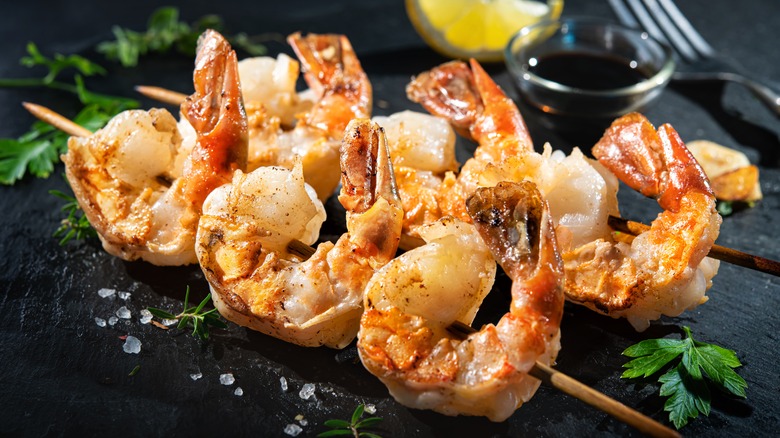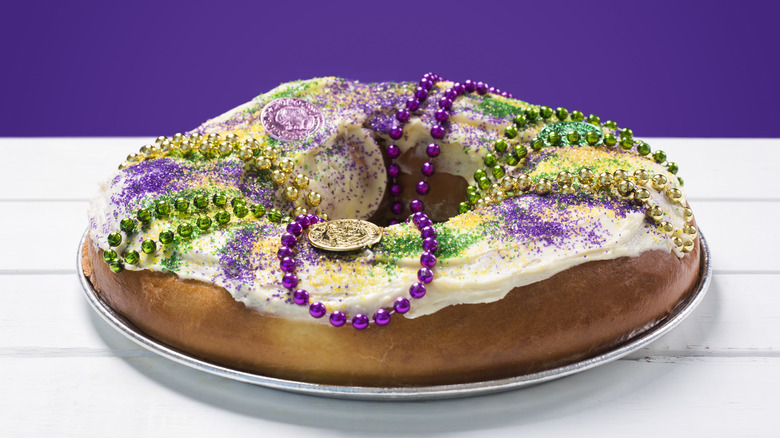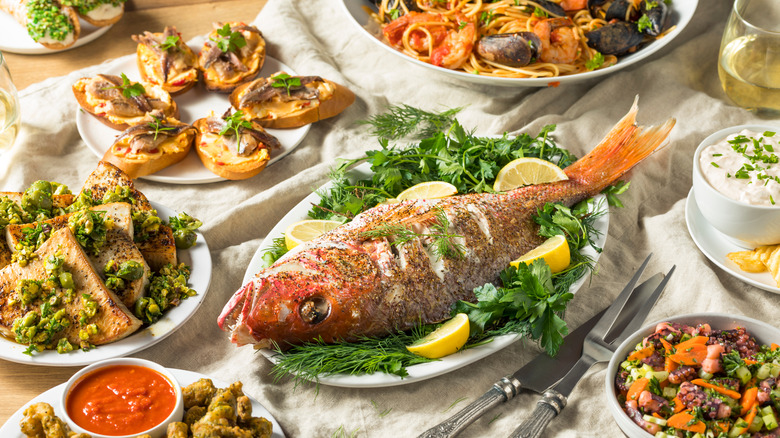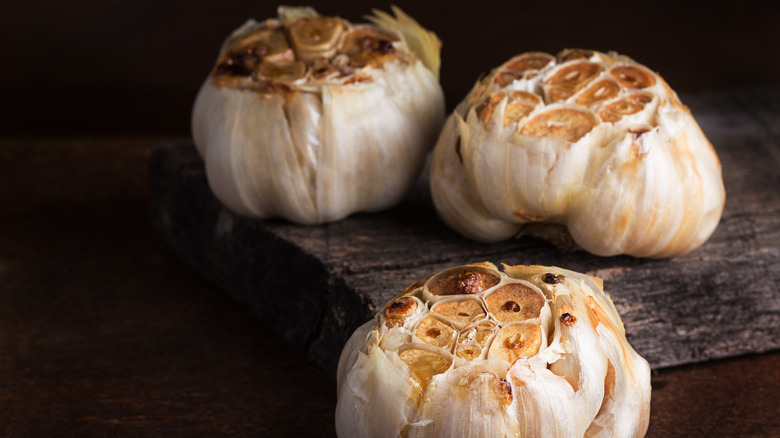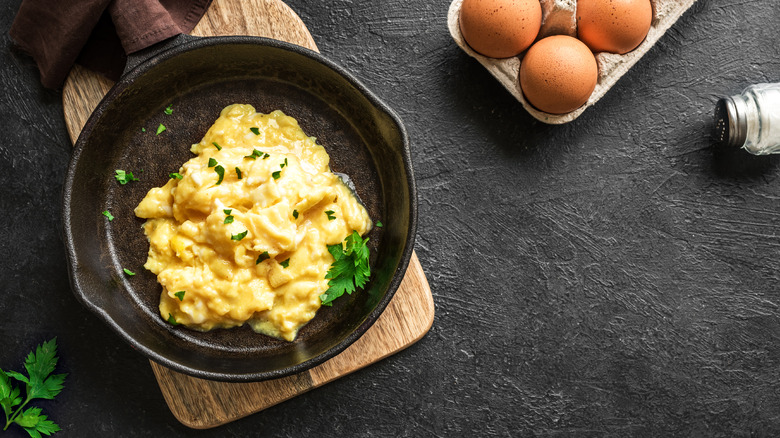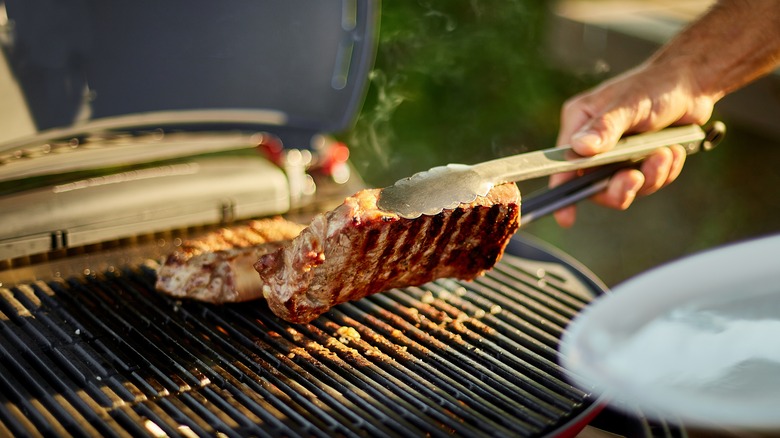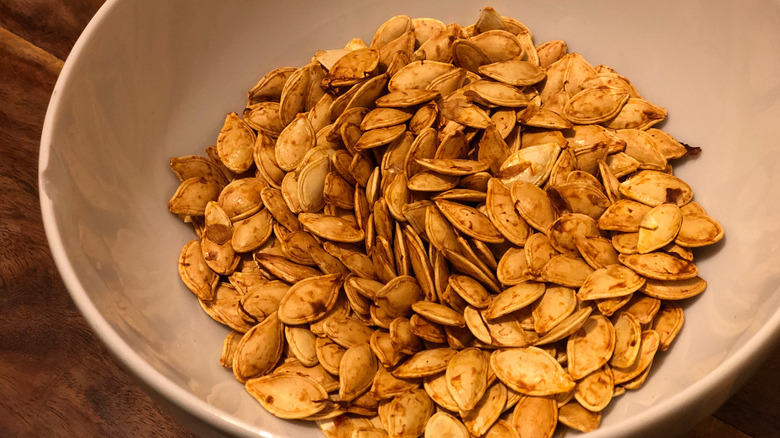Emeril Lagasse's Best Cooking Tips For Home Chefs
Chef Emeril Lagasse is one of the more recognized chefs in America. He grew up in Fall River, Massachusetts, and earned his degree from Johnson and Wales. Later, he traveled to learn French cuisine and opened his first restaurant in 1990 in New Orleans. Now, he has restaurants across the country and even sails the high seas on cruise ships.
Over the years, his accolades have mounted to be quite substantial. The James Beard Foundation has called him the Humanitarian of the Year because he has such a steadfast focus on promoting the culinary arts. Through his Food Network and Bravo shows, Americans have come to know Emeril and his flare for flavorful cooking.
While Lagasse has a great deal of history in the culinary industry and is well respected for his skill and humanitarian efforts, home cooks also appreciate and admire his work to teach budding chefs how to up their cooking game. Taking a page from Emeril's book gives you the tools to become a more confident, eclectic, and flavorful cook in your own kitchen.
Heat is important for a great roux
When cooking, there are plenty of times you need a great roux. This magical blend of flour and fat is one of the ways you can thicken your sauces and soups. Not to mention, it helps make them ultra tasty. In total, you can use four different roux in your cooking, and though these are each similar in many respects, they'll all want different cooking times.
In his Instagram video detailing how to make excellent gumbo, Emeril Lagasse says two critical points are essential when preparing roux. First, be sure that you use a wooden spoon while making your roux. This way, you can ensure that the heat of your roux is constant and not altered by the stirring utensil you use. Secondly, for your fat content, use vegetable oil. As you cook your roux, pay close attention to the thickness of your roux. If it happens to get too runny, add in flour. In the end, you'll likely find that there should be an even mix of fat to flour. One of the age-old questions of roux preparation is just how long it should take to cook, and Lagassee offers some insight and recommends you cook it for the length of time it takes to enjoy two beers.
Creole seasoning is outstanding with seafood
Lagasse's famous catchphrase, "BAM," is meant to express great flavor. While many ingredients would elicit such a response, Lagasse's favorite seasoning is none other than Creole seasoning. He explains that this is the seasoning that would inspire a response worthy of "BAM."
If you'd like to add such flavor to your food like Emeril, be aware that Creole seasoning and Cajun seasonings are related but quite different from one another in a significant way. Creole seasoning utilizes the flavors of herbs to bring its taste alive, but Cajun seasoning is free of herbs. Creole seasoning is a mixture of many different herbs you love, including thyme, oregano, basil, rosemary, and bay leaf. It also includes powders like garlic and onion powder, alongside such seasonings as paprika and cayenne pepper, to give it an extra zip. On the other hand, Cajun seasoning is a combination of peppers and powders like white, cayenne, and black pepper, as well as onion and garlic powder, with plenty of paprika. Of course, both would taste fabulous on seafood and meat, but Lagasse frequently reaches for the herb-heavy Creole option.
Turkey roulade makes for a great Thanksgiving
When it comes to preparing a great Thanksgiving feast, perhaps no item is more iconic than a whole turkey in the middle of the table. However, these birds sure do bring with them a whole host of ways to feel stressed out when preparing your family's feast. But this doesn't always have to be the case. Instead, consider making turkey roulade instead of the whole bird.
If you've never made such a dish, rest assured that Emeril Lagasse's words of wisdom will help you create an incredible main course with ease. A turkey roulade is essentially turkey breast with delicious stuffing. Begin by removing the wings and legs before pounding out the breast to flatten them and make them easier to roll. On top of the flattened breasts, add stuffing, roll it, tie it, and begin cooking. One of the best parts about a turkey roulade is that you don't need to worry about the turkey drying out or getting too crispy. Not to mention, a turkey roulade adds a lot of flavor to this fairly bland bird and even takes far less time to cook than a massive Thanksgiving turkey.
Add chorizo to stuffing
Though turkey can often be the point of confusion or frustration, so can stuffing. So many questions abound and you may wonder whether you should use the box stuff, cook it with your bird, or even opt to ignore it altogether. After all, it often ends up rather bland. Thankfully, Lagasse has a recommendation for you here, too: Add chorizo to your stuffing to give it an incredible flavor.
This simple change will add a whole lot of spice and intrigue to this basic, and perhaps boring side dish. Plus if you choose to add chorizo to the stuffing used for your turkey roulade, it will only enhance those flavors and create a cohesive meal.
So, what kind of stuffing do you start with? We recommend using a fairly simple recipe like the boxed options from Stove Top's line of stuffing. After all, the chorizo will add such a great flavor you don't want to overpower the dish with other competing tastes.
Soak corn in salt water
If you're around the Midwest in late summer, you're probably going to be having some corn on the cob before you leave. This juicy side is a near delicacy, but it also runs the risk of running a little on the dry side if you do not carefully prepare and cook it.
Lagasse has a hot tip to keep your corn on the cob moist rather than dry. Before you place your corn on the grill, you'll want to start by soaking that corn in cold water. However, a simple change can help make this soak even more effective. Rather than simply using regular water, prepare salt water to soak your corn in. This tip, shared on YouTube, creates a tender and juicy kernel. He recommends allowing it to soak for hours if possible. This substantial amount of time will require a little planning ahead, but it will certainly be worth it when you taste the outcome. After pulling your corn, you can enjoy it as a great side at a picnic or even cut it off the cob for a delicious corn chowder soup.
Grill seafood like a pro
Home cooks tend to cook what they are comfortable with repeatedly, and while many enjoy seafood from a restaurant, it can be a little finicky to cook at home. But while grilling seafood may seem intimidating, Lagasse's simple guidance on how to grill seafood should help squelch some of those concerns. Lagasse recommends choosing some large shrimp for a great fish to start with. Prepared simply with olive oil, salt, and lemon, shrimp is the perfect way to begin.
Before you set your seafood on the grill, allow it to come to room temperature and hang out there for 30 minutes or more. This will help ease that stickiness that often comes when you take seafood directly from the refrigerator and place it on the grill. Then, once it is on the grill, cook it slowly and let it do its thing.
Once you're ready to take that fish off the grill, don't ignore it. The final touch is one of the most critical parts, so be sure to dress it in some sea salt and lemon at the very least. If you're hoping for a finisher with a little more color and vibrant flavor, chimichurri would also work well and brighten that fish right up.
Make your very own King Cake
When it comes to delicious and sweet dishes from New Orleans, perhaps none is as famous as King Cake. Though it may be tempting to pick up a King Cake from your local supermarket, these cakes can easily be made from home, and Emeril's Tres Leches King Cake tastes even better than those you may find in a supermarket bakery.
For this recipe, you'll combine your flour, baking soda, baking powder, and salt. A separate bowl should have whisked egg whites, whipped until you get some medium peaks. Add sour cream, milk, vanilla, and cinnamon in a third bowl. You'll then work on combining everything in your stand mixer before moving it to a cake pan.
Then, once it's all cooked and out of your oven, prepare a white glaze or frosting and decorate it to your heart's content. You'll frequently find gold, green, and purple sprinkles covering these cakes as well as a miniature baby. You can hide a little plastic baby within the cake or even under a slice as you serve it. Whoever finds the baby should throw the next party or bring cake the next time to keep the party rolling right along.
Include seafood in holiday meals
During the holidays, it's easy to fall into lockstep with what you've always done. Classic family dishes bring us comfort and are something we look forward to all year, but that doesn't mean you can't realize new traditions for your family. Lagasse, for example, has lots of fish during the holidays.
On Christmas Eve, the Lagasses enjoy The Feast of the Seven Fishes though they often enjoy far more than seven fishes. Since Lagasse's cooking style also has a heavy New Orleans influence, and there is a great deal of seafood in New Orleans, Lagasse also offers fish from this style of cuisine.
If you don't currently serve seafood, consider it. Adding seafood dishes would also be a nice break from the other meat-heavy dishes typical in the winter holidays. This adds a little balance to your offerings. Though Lagasse relies primarily on seafood flavors from his own upbringing, that doesn't mean they have just as much a place at your table as they do at Lagasse's.
Roast garlic for delicious flavor
When it comes to adding flavor to your food, Lagasse doesn't just reach for Creole seasoning; he also recommends roasted garlic. Taking raw garlic and roasting it in the oven takes this otherwise sharp-tasting food and makes it smooth, slightly sweet, and rich.
On YouTube, Lagassee demonstrates taking a bulb of raw garlic, cutting off the top to show the tops of your garlic cloves, and placing them on a foil sheet. Take that garlic and drizzle olive oil on top and sprinkle it with salt as well as pepper. Then, wrap it up so it creates a pouch of sorts. This pouch does not need to be tight, just enclosed all around.
Put that pouch in your 400-degree Fahrenheit oven for an hour or so. Once it's done, pull out the pouch. To remove each clove, you only need to squeeze a little, and they come right out. Lagasse uses a fork to help encourage the cloves to slide out. You can use this delicious roasted garlic in whatever you'd like, but Lagasse specifically calls out how delicious it is on pizza and mixed in with mashed potatoes. He also recommends blending up several cloves, adding a little olive oil, and preserving this in the refrigerator for your future use on bread as a savor spread.
Wait patiently when making eggs
When beginning to cook, we often learn a few small skills first. One of the simplest dishes you can make is scrambled eggs, and if done properly, this dish can be fluffy and a perfect conduit for other toppings like salsa, cheese, and sour cream.
On YouTube, Lagasse explains that there are three things you need to do to create the perfect scrambled eggs. First, he recommends adding a little cream and whisking it in with your eggs before cooking them. Add butter to a nonstick pan over medium-high heat. After the butter is melted, put in your eggs mixed with cream and let them cook until the edges are set. Use your rubber spatula to move the eggs around your pan until you are pleased with how they have cooked. For the final touch, serve these eggs on a warm plate with desired toppings and accompaniments to amp up your scrambled eggs.
For serving purposes, you can also enjoy your scrambled eggs on top of buttered toast, with avocado toast, or even as an egg sandwich between two pieces of bread. This way, your humble scrambled eggs become even more substantial and can serve as a satisfying, fairly quick, and simple lunch.
Follow Emeril's advice for grilling
Lagasse offers plenty of grilling tips to Deep South Magazine that helps you create incredible meals. From cleaning your grill to checking the temperature of your meat, there are plenty of ways you can master the art of the grill.
When it comes to flavor, it all starts with marinades and spices. Consider choosing your favorite vinaigrette or reaching for accompanying spices that take your meat to the next level. Your meat will only be flavorful if you add flavor to it. Speaking of sauces, please understand that your sugary sauces will burn if they are applied too early. For this reason, hold off on those sugary sauces till the end of your cooking. When it comes to grilling burgers, have a light touch. Unless you are intentionally preparing smash burgers, try to keep yourself from pressing down on your burgers. Doing so will release all of that juice from your burgers.
To take the temperature of your meat throughout its cooking time, invest in an instant-read thermometer that you can keep with your grilling equipment. Then, when it is time to pick up, clean the grill while it remains hot. The best thing to do is scrape the grates of your grill right after the cooking is done.
Create a delicious snack by roasting pumpkin seeds
Pumpkins are a beautiful symbol of the fall season. We enjoy them as jack-o-lanterns and as the base for that most delicious seasonal pie: pumpkin pie. If you need help with roasting a pumpkin, Emeril recommends roasting it with olive oil, salt, and pepper and putting the flesh down to roast in a 350-degree Fahrenheit oven. However, there's more you can do with the insides of a pumpkin than roast it and prepare it for a pie. The seeds, when toasted well, are a most excellent snack.
On his YouTube channel, Lagasse shares his suggestions for cooking pumpkin seeds. Simply start by carving your pumpkin, removing the innards, and separating the seeds. Wash them very well to remove any gooey bits that may remain. Then, in a bowl, drizzle olive oil over the top with seasoning. Emeril uses his own unique blend, but many different seasonings would be delicious when used here. You could even go simple and add salt and pepper to the seeds. After all, sometimes, the most simple seasonings add the most flavor. Turn out these seeds on a baking sheet and cook at 300 degrees Fahrenheit until they are perfectly crispy.
This snack is delicious throughout the entire fall season, but be sure to keep them in an enclosed Tupperware container to ensure that they stay fresh between snacks.
Static Media owns and operates Mashed.
